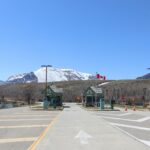Arriving in Canada on a study or work permit is a monumental step, but the final hurdle is navigating the Port of Entry (POE). A smooth process with the Canada Border Services Agency (CBSA) sets the tone for your new life. Being impeccably prepared is not just advisable; it’s essential. This guide offers expert insights into the documents, procedures, and expectations to ensure your arrival is as seamless and stress-free as possible. Understanding what CBSA officers look for and how to present your case confidently can make all the difference between a warm welcome and a complicated start.
Table of Contents
- Pre-Arrival Preparations: The Indispensable Documents for Your Canadian Entry
- Navigating the Canadian Port of Entry: A Comprehensive Step-by-Step Walkthrough
- The Pivotal CBSA Interview: Proving Your Intent and Ensuring Admissibility
- Securing Your Social Insurance Number (SIN): A Critical First Step in Canada
- Frequently Asked Questions on Arriving in Canada on a Study or Work Permit
Pre-Arrival Preparations: The Indispensable Documents for Your Canadian Entry
Your journey to Canada culminates at the border, where first impressions are critical. The foundation of a successful entry is a meticulously organized collection of documents. Before you even book your flight, it is imperative to gather and double-check every piece of paperwork required by Immigration, Refugees and Citizenship Canada (IRCC) and the CBSA. Your Port of Entry (POE) Letter of Introduction is perhaps the most important document, as it confirms IRCC’s pre-approval of your permit. However, this letter is not the permit itself and does not guarantee entry. You must also have a valid passport or travel document, ensuring it will not expire during your intended stay. For citizens of visa-required countries, a valid Temporary Resident Visa (TRV) stamped in your passport is mandatory. Those from visa-exempt countries will need an Electronic Travel Authorization (eTA). Beyond these primary items, you must be ready to present a portfolio of supporting evidence that validates the purpose of your visit and your ability to comply with Canadian immigration laws. This includes comprehensive proof of financial support, demonstrating your capacity to cover tuition, living expenses, and your eventual return journey without resorting to unauthorized work. Additionally, have copies of your Letter of Acceptance (for students) or your employment contract (for workers), any required medical exam results, and other documents submitted with your original application. Organizing these documents in a logical, accessible manner will demonstrate your preparedness and respect for the process.
Navigating the Canadian Port of Entry: A Comprehensive Step-by-Step Walkthrough
Upon landing at a Canadian airport, the immigration process typically begins at a Primary Inspection Kiosk (PIK) or an eGate. Here, you will scan your travel document, have your photo taken for identity verification, and complete an on-screen declaration. The machine will issue a receipt that you must present to a CBSA officer. Based on this initial check, you may be directed to the immigration secondary inspection area. This is a standard and mandatory step for all first-time study and work permit applicants. Do not be alarmed; this is where you will have your documents reviewed and your permit officially issued. At the secondary inspection counter, a CBSA officer will engage with you directly. They will ask for your POE Letter of Introduction, passport, and any other supporting documents they deem necessary. The officer’s primary mandate is to verify your identity, ensure you are admissible to Canada, and confirm that you still meet all the requirements of your permit. They will likely ask questions about your study plans or your job in Canada, your financial situation, and your ties to your home country. It is crucial to answer these questions truthfully, clearly, and consistently with the information provided in your application. The officer holds the final authority to issue your study or work permit and authorize your entry into Canada. Being patient, cooperative, and respectful throughout this interaction is paramount for a positive outcome.
The Pivotal CBSA Interview: Proving Your Intent and Ensuring Admissibility
The interview with the CBSA officer is more than a formality; it is a critical assessment of your eligibility and intentions. The officer must be convinced that you are a genuine temporary resident who will abide by the conditions of your stay and leave Canada at the end of your authorized period. They are trained to detect inconsistencies and potential red flags. Therefore, your honesty and transparency are non-negotiable. Be prepared to articulate your plans clearly—what you will study, where you will work, and how you will support yourself. If you are a student, be ready to discuss your program and institution. If you are a worker, know the details of your employer and your role. The officer has access to your entire application file and will cross-reference your answers with the documents you submitted. Any discrepancy, no matter how minor, can lead to further questioning and potential complications. It is vital to remember that the burden of proof rests on you, the applicant. You must actively demonstrate your admissibility.
Here are some key takeaways for a successful CBSA interview:
- Have All Documents Ready: Keep your passport, POE Letter of Introduction, proof of funds, and all supporting documents in your carry-on luggage for easy access. Fumbling through bags creates a poor impression.Answer Truthfully and Directly: Do not embellish, guess, or provide false information. If you do not know the answer to a question, it is better to say so than to invent one.Listen Carefully: Pay close attention to the officer’s questions and answer only what is asked. Volunteering unsolicited information can unnecessarily complicate the conversation.Remain Calm and Polite: The process can be intimidating, but maintaining a respectful and cooperative demeanor is crucial. CBSA officers are professionals doing their job to protect Canada’s borders.Review Your Permit: Once the officer issues your permit, review it carefully before leaving the counter. Check that your name, date of birth, and the conditions (such as employer or institution name and expiry date) are all correct. Correcting an error later can be a difficult process.
Securing Your Social Insurance Number (SIN): A Critical First Step in Canada
After successfully receiving your study or work permit, your next immediate task should be to obtain a Social Insurance Number (SIN). A SIN is a nine-digit number that you need to work in Canada and to have access to government programs and benefits. For many newcomers, this can be done conveniently at the airport immediately after clearing immigration. Most of Canada’s major international airports have a Service Canada office on-site specifically for this purpose. To apply, you will need to present your original, valid study or work permit issued by the CBSA officer, along with your passport. The process is typically quick and straightforward. A Service Canada agent will verify your documents and, if everything is in order, issue your SIN on a printed confirmation letter during the same visit. It is highly beneficial to complete this step at the airport, as it saves you a separate trip to a Service Canada Centre later. Your SIN is confidential and should be protected. You will need to provide it to your employer for payroll purposes and to your financial institution when opening an account. For students whose study permit allows them to work, obtaining a SIN is an essential step to be able to take advantage of on-campus or off-campus work opportunities legally. Getting your SIN upon arrival is one of the most efficient first steps you can take to get settled in Canada.
Frequently Asked Questions on Arriving in Canada on a Study or Work Permit
What is a Port of Entry (POE) Letter of Introduction?
A POE Letter of Introduction is the official document you receive from IRCC after your study or work permit application is approved. It is not the permit itself but a confirmation of approval that you must present to the CBSA officer upon arrival in Canada. The officer will then use this letter to issue your official permit.
What does a CBSA officer do at the border?
A CBSA officer is a federal law enforcement agent responsible for border control, immigration, and customs services. When you arrive, their job is to verify your identity, confirm your admissibility to Canada, and ensure you meet all legal requirements before issuing your official study or work permit and granting you entry.
How much proof of funds do I need to show at the border?
You must be prepared to show that you have sufficient funds to support yourself (and any family members) during your stay. The amount should be consistent with what you declared in your permit application and meet the minimum financial requirements set by IRCC for students and temporary workers. Having recent bank statements or other financial documents readily available is crucial.
Can I get my Social Insurance Number (SIN) at the airport?
Yes, most major international airports in Canada have a Service Canada office where you can apply for your SIN immediately after you have been issued your work or study permit. You will need to present your new permit and your passport. This is the most convenient way to obtain your SIN.
What happens if there is a mistake on my work or study permit?
It is essential to review your permit for any errors—such as a misspelled name, incorrect expiry date, or wrong employer details—before you leave the CBSA counter. If you spot a mistake, bring it to the officer’s attention immediately so it can be corrected. Correcting an error after you have left the airport can be a much more complicated and lengthy process.
Talk to us to find out more. ->
The content above is not intended to provide legal advice or opinions of any kind and may not be used for professional or commercial purposes.







